新课标九年级英语unit6教学设计
- 格式:doc
- 大小:155.00 KB
- 文档页数:8
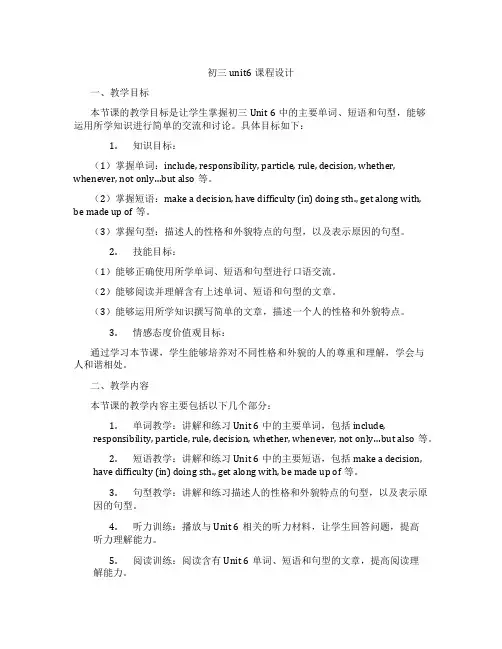
初三unit6课程设计一、教学目标本节课的教学目标是让学生掌握初三Unit 6中的主要单词、短语和句型,能够运用所学知识进行简单的交流和讨论。
具体目标如下:1.知识目标:(1)掌握单词:include, responsibility, particle, rule, decision, whether, whenever, not only…but also等。
(2)掌握短语:make a decision, have difficulty (in) doing sth., get along with, be made up of等。
(3)掌握句型:描述人的性格和外貌特点的句型,以及表示原因的句型。
2.技能目标:(1)能够正确使用所学单词、短语和句型进行口语交流。
(2)能够阅读并理解含有上述单词、短语和句型的文章。
(3)能够运用所学知识撰写简单的文章,描述一个人的性格和外貌特点。
3.情感态度价值观目标:通过学习本节课,学生能够培养对不同性格和外貌的人的尊重和理解,学会与人和谐相处。
二、教学内容本节课的教学内容主要包括以下几个部分:1.单词教学:讲解和练习Unit 6中的主要单词,包括include,responsibility, particle, rule, decision, whether, whenever, not only…but also等。
2.短语教学:讲解和练习Unit 6中的主要短语,包括make a decision,have difficulty (in) doing sth., get along with, be made up of等。
3.句型教学:讲解和练习描述人的性格和外貌特点的句型,以及表示原因的句型。
4.听力训练:播放与Unit 6相关的听力材料,让学生回答问题,提高听力理解能力。
5.阅读训练:阅读含有Unit 6单词、短语和句型的文章,提高阅读理解能力。
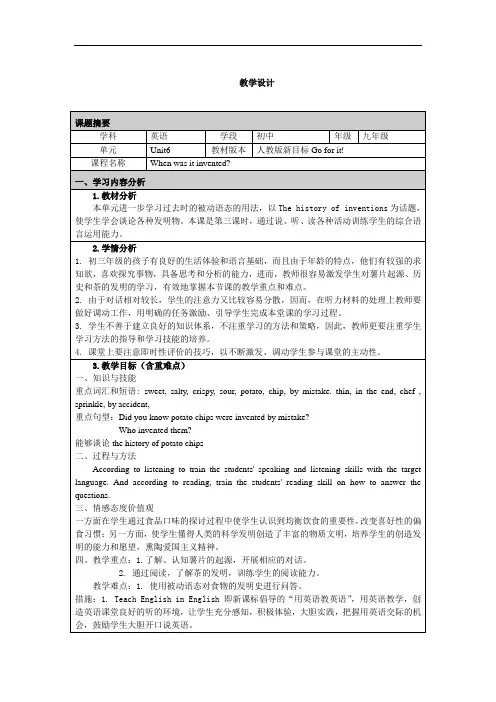
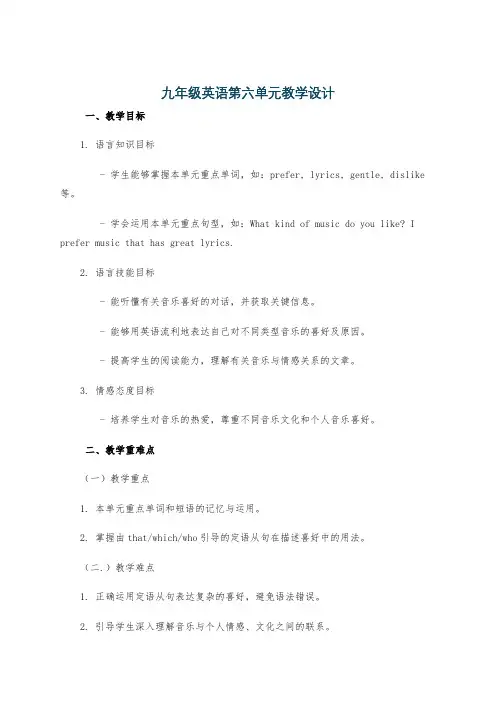
九年级英语第六单元教学设计一、教学目标1. 语言知识目标- 学生能够掌握本单元重点单词,如:prefer, lyrics, gentle, dislike 等。
- 学会运用本单元重点句型,如:What kind of music do you like? I prefer music that has great lyrics.2. 语言技能目标- 能听懂有关音乐喜好的对话,并获取关键信息。
- 能够用英语流利地表达自己对不同类型音乐的喜好及原因。
- 提高学生的阅读能力,理解有关音乐与情感关系的文章。
3. 情感态度目标- 培养学生对音乐的热爱,尊重不同音乐文化和个人音乐喜好。
二、教学重难点(一)教学重点1. 本单元重点单词和短语的记忆与运用。
2. 掌握由that/which/who引导的定语从句在描述喜好中的用法。
(二.)教学难点1. 正确运用定语从句表达复杂的喜好,避免语法错误。
2. 引导学生深入理解音乐与个人情感、文化之间的联系。
三、教学方法1. 情景教学法- 通过创设各种与音乐相关的情景,如音乐派对、电台节目等,让学生在真实的语境中学习和运用英语。
2. 任务驱动法- 布置各种任务,如小组讨论音乐喜好、制作音乐推荐海报等,促使学生积极参与课堂活动,提高语言运用能力。
3. 游戏教学法- 利用音乐猜谜、歌词接龙等游戏,增加课堂的趣味性,激发学生的学习兴趣。
四、教学过程(一)导入(5分钟)1. 播放一段各种类型音乐混合的音频片段,有流行音乐(pop music)、摇滚(rock music)、古典音乐(classical music)、民谣(folk music)等。
- 老师说:“Hey, guys! Just now we listened to a musical feast. I bet you heard some really cool tunes. So, raise your hands if you liked what you heard.”- 请几位学生分享一下他们在音频中听到了哪些类型的音乐,以及他们的初步感受。
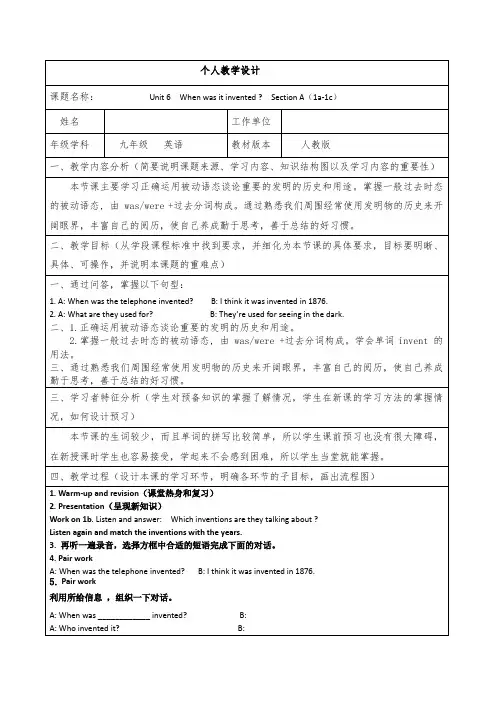
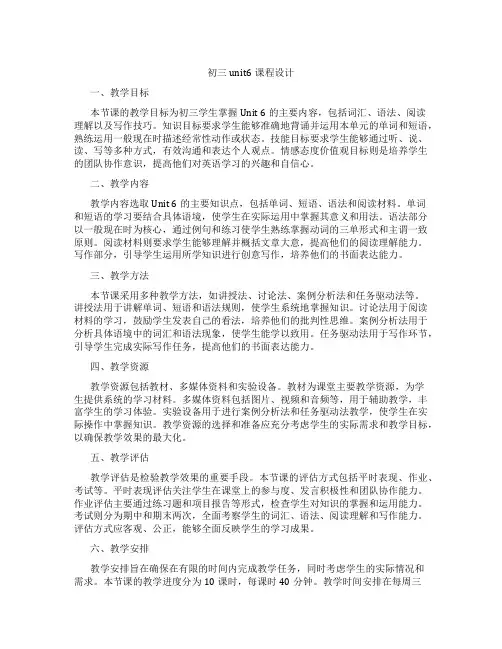
初三unit6课程设计一、教学目标本节课的教学目标为初三学生掌握Unit 6的主要内容,包括词汇、语法、阅读理解以及写作技巧。
知识目标要求学生能够准确地背诵并运用本单元的单词和短语,熟练运用一般现在时描述经常性动作或状态。
技能目标要求学生能够通过听、说、读、写等多种方式,有效沟通和表达个人观点。
情感态度价值观目标则是培养学生的团队协作意识,提高他们对英语学习的兴趣和自信心。
二、教学内容教学内容选取Unit 6的主要知识点,包括单词、短语、语法和阅读材料。
单词和短语的学习要结合具体语境,使学生在实际运用中掌握其意义和用法。
语法部分以一般现在时为核心,通过例句和练习使学生熟练掌握动词的三单形式和主谓一致原则。
阅读材料则要求学生能够理解并概括文章大意,提高他们的阅读理解能力。
写作部分,引导学生运用所学知识进行创意写作,培养他们的书面表达能力。
三、教学方法本节课采用多种教学方法,如讲授法、讨论法、案例分析法和任务驱动法等。
讲授法用于讲解单词、短语和语法规则,使学生系统地掌握知识。
讨论法用于阅读材料的学习,鼓励学生发表自己的看法,培养他们的批判性思维。
案例分析法用于分析具体语境中的词汇和语法现象,使学生能学以致用。
任务驱动法用于写作环节,引导学生完成实际写作任务,提高他们的书面表达能力。
四、教学资源教学资源包括教材、多媒体资料和实验设备。
教材为课堂主要教学资源,为学生提供系统的学习材料。
多媒体资料包括图片、视频和音频等,用于辅助教学,丰富学生的学习体验。
实验设备用于进行案例分析法和任务驱动法教学,使学生在实际操作中掌握知识。
教学资源的选择和准备应充分考虑学生的实际需求和教学目标,以确保教学效果的最大化。
五、教学评估教学评估是检验教学效果的重要手段。
本节课的评估方式包括平时表现、作业、考试等。
平时表现评估关注学生在课堂上的参与度、发言积极性和团队协作能力。
作业评估主要通过练习题和项目报告等形式,检查学生对知识的掌握和运用能力。
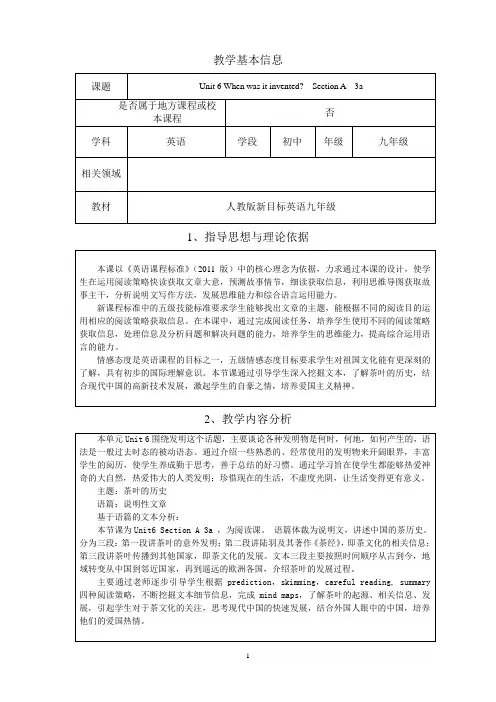
教学基本信息1、指导思想与理论依据2、教学内容分析3、学生情况分析4、教学目标5、教学重、难点6、教学流程图7、教学过程Lead-in (2mins )Ask Ss to look atpictures ofdifferent drinksand then answerquestions:1. What will youdo if you arereally thirsty?2. What’s the mosttraditional drink inChina?3. Who inventedtea?Ss look at thepictures andanswer:1.I’d like todrink....2.Tea.3. Shen Nong.Pictures about different drinks,especially tea, and introduceShen Nong.让学生想一想当他们渴的时候,想喝什么。
由此导入到本课话题中国传统饮品——茶。
提供相关图片介绍神农以及茶叶的意外发明。
由此激活他们已有语言结构和对关于阅读内容的相关知识背景。
为下面文本的学习做铺垫。
Before reading (4mins)1. Ask a question:Do you know howtea was invented?2. Show the title:An AccidentalInvention, ask:What can youpredict from thetitle and thepicture?3. Pictures showthe process of thattea was inventedby accident.Ss look at thepictures and theprocess of tea toknow the tea wasinvented byaccident.How was the tea invented?boil water over an open firefall into …and remain…produce a nice smelltaste the brown water—teaIt was invented by accident.Pictures show the process oftea’s inventionReadingstrategy1:Prediction借助图片和标题预测文本的大概内容,激发学生阅读语篇的欲望。
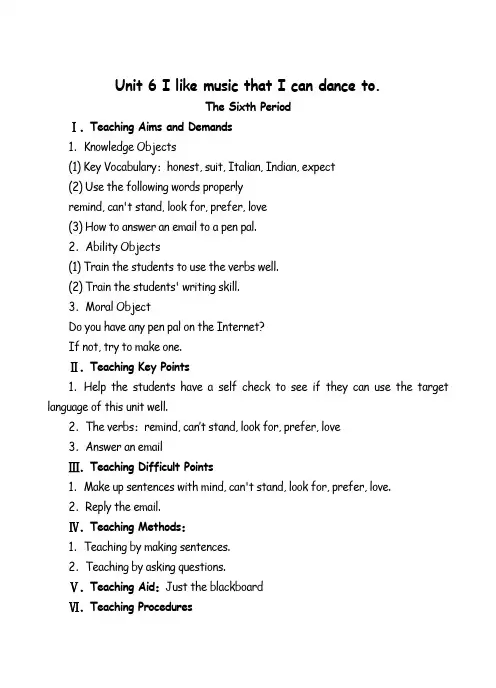
Unit 6 I like music that I can dance to.The Sixth PeriodⅠ.Teaching Aims and Demands1.Knowledge Objects(1) Key Vocabulary:honest, suit, Italian, Indian, expect(2) Use the following words properlyremind, can't stand, look for, prefer, love(3) How to answer an email to a pen pal.2.Ability Objects(1) Train the students to use the verbs well.(2) Train the students' writing skill.3.Moral ObjectDo you have any pen pal on the Internet?If not, try to make one.Ⅱ.Teaching Key Points1.Help the students have a self check to see if they can use the target language of this unit well.2.The verbs:remind, can’t stand, look for, prefer, love3.Answer an emailⅢ.Teaching Difficult Points1.Make up sentences with mind, can't stand, look for, prefer, love.2.Reply the email.Ⅳ.Teaching Methods:1.Teaching by making sentences.2.Teaching by asking questions.Ⅴ.Teaching Aid:Just the blackboardⅥ.Teaching ProceduresStep Ⅰ Revision(1) Check the homework. First let the students show their rewritten reviews to see if they have finished it. Second, dictate these words: entertainment, feature, wife, photography, exhibition, suggest, energy.(2) Revise the three reviews in Activity 3a by asking some questions.(3) Let the children read the three reviews aloud. After a while, ask several to read them to the class. Correct any pronunciation errors if necessary. After that let them read the passages by themselves again.Step Ⅱ Part 1This activity provides a comprehension review of vocabulary presented in this unit.Focus attention on the box. Invite a student to read the vocabulary words at the top. You are asked to fill in the blanks with the words. In some cases, you may need to use another form of the word, for example, adjusting for tense or subject/verb agreement.Ask students to fill in the blanks on their own. Check the answers. Five students each read a sentence, filling in the blanks. The rest of the students check their work.Answers:1.prefer 2.reminds 3.looking for 4.love 5.can't standAsk students to make their own sentences with the words, preferably sentences that are meaningful. Move around the room. Collect a few students' answers with mistakes on the blackboard. Along with the students help correct the mistakes.Suggested answers1.The girl reminds him of his daughter.2.Tom can't stand the hot weather.3.They are looking for a nice cinema to see a film.4.We love having a good rest at home on Sunday.5.Lily prefers dumplings to noodles.Step Ⅲ Part 2This activity provides reading and writing practice using the target language.Read the instructions to the students.Ask, what is the subject of this email?Whom is it from? and Who wrote the email? Ask three students to answer the questions.Please read the email silently now. Try to tell me what Lingling wants to know about you/her pen pal after reading it. Pick out the questions that Lingling asks in her email. Then let the students read the email for a while. After all of them have finished reading, ask someone to tell me what Lingling wants to know about her pen pal. Write the questions that Lingling asks in the email on the blackboard:(1) What language would you like to learn?(2) What kinds of music do you like?(3) What kinds of food do you prefer?(4) Have you ever seen an Indian film?(5) What kinds of films do you prefer?After that ask some questions about lingling to see if they understood the email.(1) What language might lingling like to learn some?(2) Why is Lingling in Hong Kong now?(3) Which city does Lingling prefer, Hong Kong or Shanghai?(4) What did she do last night?(5) What kind of music does she prefer? ect.Ask as many questions as possible if time permits. Try to make it clear what the students couldn't understand about the email by asking them to answer the questions, and give them some explanation where necessary, especially the new vocabulary.Teach the new vocabulary by giving example sentences and asking the children to make up more sentences with them.For example, teach honest like this:Honest is used to describe someone who doesn't lie. For example, Amy is anhonest girl. (Tell the students to use an before honest.) We should be honest. Who can make up more sentences with honest now? Let a few students say their sentences out to the class.Do the same with the other new words.Ask one student to read the email. Correct any pronunciation errors to make sure the students are providing a good model for the rest of the class. Ask all the students to read the email aloud once.Next tell the students to write the reply to Lingling. Say, you are Lingling's pen pal now. Please write a reply to Lingling now. Look at the questions on the blackboard. Your email should include all the answers of the five questions. Write in the form of a letter.Ask students to complete the work on their own. After they all have finished the letter, ask a few students to read their replies to the class. Answers will vary, but note to check if they include details of about the same length as the email they are replying to.Step Ⅳ Just for Fun!This activity provides reading and speaking practice with the target language.Ask all the students to read the sentence in the picture together. Then ask them what is funny about this cartoon. Help them to answer, we usually think of people, not dogs, singing along with a band.Step Ⅴ SummarySay, In this class, we've received some vocabulary words presented in this unit.And we've also made up sentences using these words. Another thing we've done is that we have written a reply email.Step Ⅵ Homework(1) Review all the language points in this unit.(2) Finish off the exercises on pages 23~25 of the workbook.Step Ⅶ Blackboard DesignUnit 6 I like music that I can dance to.Self checkThe Sixth Period Questions in Ling ling’s email:(1) What language would you like to learn?(2) What kinds of music do you like?(3) What kinds of food do you prefer?(4) Have you ever seen an Indian film?(5) What kinds of films do you prefer?。
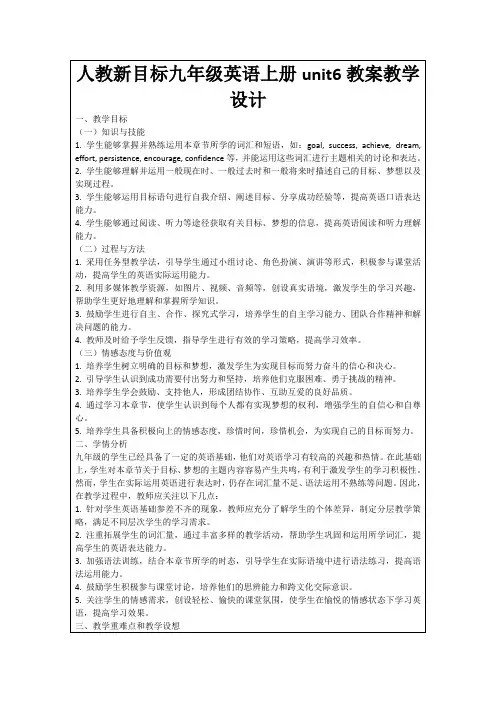
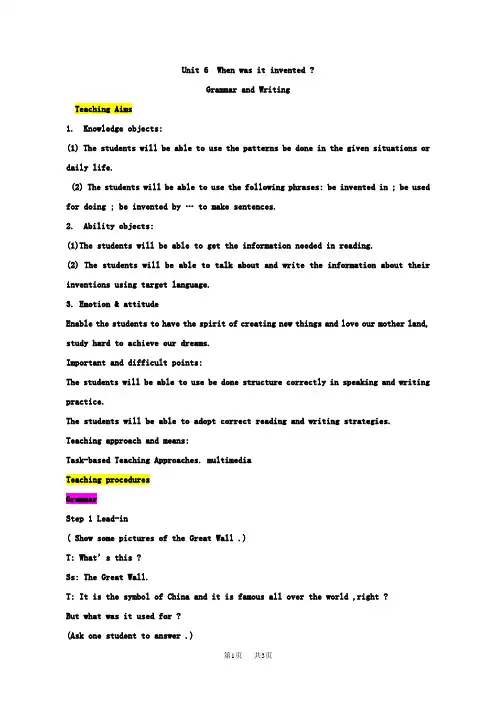
Unit 6 When was it invented ?Grammar and WritingTeaching Aims1. Knowledge objects:(1) The students will be able to use the patterns be done in the given situations or daily life.(2) The students will be able to use the following phrases: be invented in ; be used for doing ; be invented by … to make sentences.2. Ability objects:(1)The students will be able to get the information needed in reading.(2) The students will be able to talk about and write the information about their inventions using target language.3. Emotion & attitudeEnable the students to have the spirit of creating new things and love our mother land, study hard to achieve our dreams.Important and difficult points:The students will be able to use be done structure correctly in speaking and writing practice.The students will be able to adopt correct reading and writing strategies. Teaching approach and means:Task-based Teaching Approaches. multimediaTeaching proceduresGrammarStep 1 Lead-in( Show some pictures of the Great Wall .)T: What’s this ?Ss: The Great Wall.T: It is the symbol of China and it is famous all over the world ,right ?But what was it used for ?(Ask one student to answer .)Step 2 Pair workA: What was it used for ?B: It was used for sending messages.T: Be used for…is Passive Voice.More practice:A : When was it invented ?B: It was invented in…A: Who was it invented by ?B: It was invented by…A: What is it used for?B: It is used for…A: What do you think of it ?B: I think it…Some exercise.ReadingStep 1 Read and fill in the blanks.Check the answers.Pay attention to the structure of the passage .Step 2 More reading1.T: Here is a passage about inventions ! Go through the picture with the students.2. Let the students read again and answer the questions below the passage.(Then check the answers and let the students to choose the reading strategy they adopted in reading and share it in class.)GroupworkStep 1 Cooperate to designT: Well done dear students! Now it’s time to cooperate to design. Discuss these problems in your group and we’ll show your design to see which group is the best one. Ask students to have a discussion in groups and then design their own tools. All the problems should be solved by themselves.Step 2 Share the designs in classEveryone in the group are supposed to say something about their inventions . Each of them have a chance to talk in class.(Give them the standards about how to make an estimate of each invention. Let the students show their own ideas about other inventions. ) Writing1. Write their own introductions of their design.2. Share the passages in class so that the students can learn more information about each invention. In this way each student can improve their own writing ability.Ending:T: As the hosts of the 21st century , we have the duty to make our country stronger and stronger ,what should we to do to achieve our China Dream ?Ss: We should study hard!Together : Let’s study hard and achieve our China Dream !!Homework:T: In this class all of you did very well, and you helped me a lot, thank you! Here’s today’s homework:1. Rewrite the articles .2. What else do you want to invent in the future ?Tell us something about your ideas next class.。
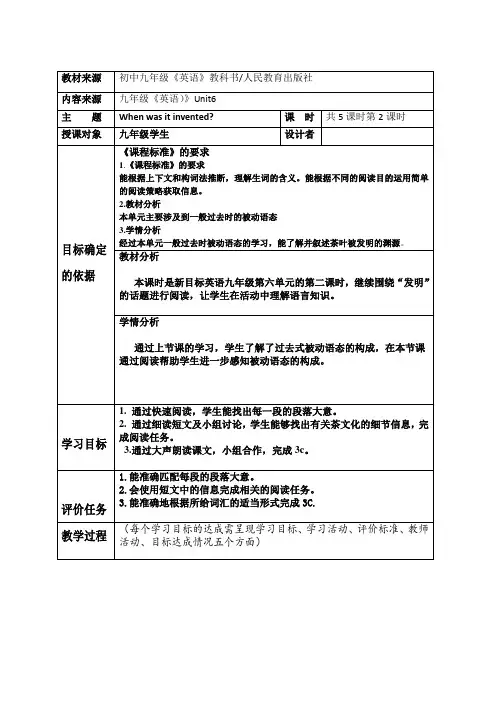
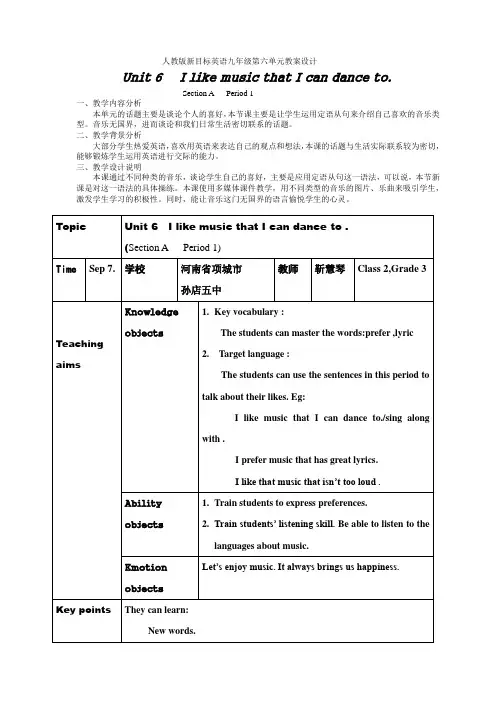
人教版新目标英语九年级第六单元教案设计
Unit 6 I like music that I can dance to.
Section A Period 1
一、教学内容分析
本单元的话题主要是谈论个人的喜好,本节课主要是让学生运用定语从句来介绍自己喜欢的音乐类型。
音乐无国界,进而谈论和我们日常生活密切联系的话题。
二、教学背景分析
大部分学生热爱英语,喜欢用英语来表达自己的观点和想法,本课的话题与生活实际联系较为密切,能够锻炼学生运用英语进行交际的能力。
三、教学设计说明
本课通过不同种类的音乐,谈论学生自己的喜好,主要是应用定语从句这一语法,可以说,本节新课是对这一语法的具体操练。
本课使用多媒体课件教学,用不同类型的音乐的图片、乐曲来吸引学生,激发学生学习的积极性。
同时,能让音乐这门无国界的语言愉悦学生的心灵。
附:
教师个人介绍:
靳慧琴:从事英语教学三年,工作在教学第一线,参加过英语教学公开课比赛并取得一定的成绩。
本人喜爱自己从事的英语教学工作,经常用英语和自己的学生谈谈心,在素质教育实施的过程中,竭尽所能,不断追求着……。
Unit 6 When was it invented?Unit 6 Section A 1 (1a-2d)一、教学目标:1. 语言知识目标:1) 能掌握以下单词:heel, scoop, electricity, style, project, pleasure, zipper, daily, website,pioneer, list, mention能掌握以下句型:①—When was the telephone invented? —I think it was invented in 1876.②—What are they used for? —They are used for seeing at night.2) 能谈论物品被发明的时间、发明者,表达某发明的用途。
2. 情感态度价值观目标:了解一些近现代发明的时间及用途,激发自己热爱发明的情感。
培养想象力,善于观察事物。
面对难题,用积极的态度去解决,发挥想象力,认识世界,改造世界。
二、教学重难点1. 教学重点:1) 本课时的单词、词组和句型,学习运用一般过去时态的被动语态。
2) 学会询问发明时间及用途的基本句型:—When was the telephone invented? —I think it was invented in 1876.—What are they used for? —They are used for seeing at night.2. 教学难点:运用一般过去时态的被动语态来讨论发明的发明时间及用途。
三、教学过程I. Warming up1. 展示一些近代发明的图片与近代发明的发明者,让学生们将图片与发明者相连。
T: Do you know what these inventions are? S1: It’s a car.S2: It’s a telephone. S3: It’s a television.T: Do you know who these inventors are? S1: Karl BenzS2: Alexander Bell S3: J. L. BairdLet Ss match the inventions and the inventors.Ⅱ. Presentation引导学生们学习一般过去时态的被动语态结构。
新课标九年级英语unit6教学设计Unit6 Reading He used to cause a lot of trouble.一Teaching Aims and Demands1. Knowledge Objects(1).70% of the students can read and write the key vocabulary: death, afford, cause, himself, patient, in the end, decision, make a decisi on, head teacher, necessary, to one’s surprise, exactly, even though, no longer, take pride in, pay attention to, give up, waste, not…any more(2). Key structures:通过本节课的学习,熟练运用used to 结构.His mother couldn’t afford to pay for her child’s education..Even though my father was no longer with us, he was watching me, and would always take pride in everything good I do.2. Ability ObjectsTo train students’ reading ability.3.Emotion and attitude goals:Get the students to know their shortcomings in the past. Encourage the students to make themselves more perfect in their life and study in the future.二、重难点:1、理解短文内容,正确处理有关的信息。
九年级英语unit6教案教案标题:九年级英语 Unit 6 教案教学目标:1. 通过本单元的学习,学生能够掌握并正确运用本单元的词汇和短语。
2. 能够理解并正确运用本单元的语法知识,包括过去进行时和一般过去时。
3. 能够听懂并正确运用本单元的听力材料,包括听力技巧和听力策略。
4. 能够运用所学知识进行口语表达和书面表达。
教学重点:1. 学习并掌握本单元的词汇和短语。
2. 理解并正确运用过去进行时和一般过去时。
3. 提高听力技巧和听力策略。
教学难点:1. 理解并正确运用过去进行时和一般过去时。
2. 提高听力技巧和听力策略。
教学准备:1. 教材:九年级英语教材 Unit 6。
2. 多媒体设备:投影仪、音响设备。
3. 教学素材:课件、练习册、录音机。
教学过程:Step 1: 导入新课 (5分钟)1. 创设情境,引入新课。
可以通过展示一张旅行的照片或者一个旅行故事来引起学生的兴趣。
2. 通过提问,激发学生对旅行的兴趣和想法。
Step 2: 词汇和短语学习 (15分钟)1. 呈现并教授本单元的重点词汇和短语。
可以使用图片、例句等方式进行教学。
2. 组织学生进行词汇和短语的操练和记忆,可以采用配对练习、填空练习等形式。
Step 3: 语法知识学习 (20分钟)1. 介绍和讲解过去进行时和一般过去时的用法和构成。
2. 通过例句和练习,让学生理解并掌握这两种时态的用法和区别。
3. 组织学生进行语法练习,巩固所学知识。
Step 4: 听力训练 (20分钟)1. 播放本单元的听力材料,让学生尝试听懂并回答相关问题。
2. 教授听力技巧和策略,帮助学生提高听力水平。
3. 组织学生进行听力练习,加强听力训练。
Step 5: 口语和书面表达 (15分钟)1. 组织学生进行口语练习,让他们运用所学知识进行对话或者小组讨论。
2. 引导学生进行书面表达,可以给出写作题目或者情境,让学生进行写作练习。
Step 6: 小结与作业布置 (5分钟)1. 对本节课的内容进行小结和总结,梳理学生的学习成果。
Unit 6 When was it invented?(第2课时)一、教材分析:本课选自初中英语新人教版九年级(2014)新改版。
谈论的话题是有关“发明”的话题。
要掌握的结构是被动语态。
本课时的教学内容是听力与口语相结合,重难点是词汇和短语教学。
二、三维目标:1.知识和技能目标:1)谈论重要发明的发明时间,发明者和用途。
2) 了解薯条、茶和篮球的发明历史。
2.过程与方法目标:1)能运用所学知识练习被动语态的句式。
2)能用所学句型进行交际练习。
3.情感、态度和价值观目标:充满想象力,善于观察事物,面对难题,用积极的态度解决,发挥创造能力,认识世界,改变世界。
三、教学重点:单词,短语和句型。
四、教学难点:运用被动语态谈论重要发明的时间、发明者和用途。
五、教学策略:通过谈论重要发明的练习,充分掌握被动语态的用法.六、教学准备:多媒体课件教科书课前预习学案。
七、教学环节:DISCOVERING LANGUAGE(1).Look at the screen and complete the questions. Let the students do it by themselves on their books,and ask one to show his answers to the class. The answers are:1)It was invented in 1876.2)It is used for traveling.3) It is used for seeing in the dark.4)It is used for serving really cold ice cream.(2). Complete the following questions;using the word cues;make necessary changes. Let students do it by themselves and the teacher move around the classroom,give them the necessary help. Check the answers:1). invented2). drinked3). produced4). brought5). tradedDEVELOPING SKILLS1. Listen and choose the best response to what you hear. First listen only, then do it the second time.2. Listen to Miss Green’s lecture and decide whether the following statements are true or false. Make the answers by class themselves.3. Work in pairs.Interview the partners in your group, ask them some questions and write down, then report to the class.Read the passage and choose the best answersTell the students to read the dialogues carefully,and think it over,then complete it. First ask the students talk about his or her answers with classmates. Check the answers :4b. 1. were invented2. were brought3. was locked ; rang4. were telled ; broke5. were eaten ; liked4c. was invented ; was born ; worked ;learned ; was invented ; was said ;was usedhomework1.Write a passage about a new invention and introduce it.2.Do some relevant exercises .(设计说明:运用并拓展本课时所学知识,让学生在写作中进一步巩固所学知识,并掌握本课时的新词和短语。
Unit 6 I like music that I can dance toThe 1st PeriodⅠ. Teaching Aims1. Knowledge Objects(1) Key Vocabulary prefer, lyric(2) Target LanguageWhat kind of music do you like?I like music that I can sing along with.What about you?I prefer music that has great lyrics.2.Ability Objects(1) Train the students to express preferences.(2)Train the students’ listening skill.(3) Train the students use the Attributive Clause.3. Moral ObjectLet’s enjoy music. It always brings us happiness.Ⅱ. Teaching Key Points1. Key Vocabulary and phrases: prefer, lyric, dance to, sing along with 2. Target LanguageⅢ. Teaching Difficult Points1. Relative clauses with that and who2. The listening practiceⅣ. Teaching Methods1. Chain drill 2. PairworkⅤ. Teaching AidsA computer and PPTⅥ. Teaching ProceduresStep Ⅰ Lead in1. Beginning the class with a short movie “ Sounds of Music”2. Ask some students about: Do you like music? What music do you like ? What kind of music do you like? And write down their answers about the kinds and reasons.3. Show students different kinds of music, and find some adjective words to describe them. Then, show two sentences about the music, and show how to combine them into one.4. Make some more sentences like that. And everyone say a sentence.Step Ⅱ 1aThis activity introduces the key vocabulary and trains the students to express preferences with the relative clause.Write…that are red on the blackboard.Ask students to look at the PPT again, read out the relative clause sentences aloud.Step Ⅲ 1bSay, we will hear Tony and Betty talking about the kinds of music each one likes.Let’s see the instructions first. Read the instructions to the students. Tell them to tick (√) the right statements while they are listening. Read the three headings before playing the tape.Play the tape the first time and the students only listen. Then play it for a second time. The students tick in the right answer boxes.Cheek the answers.Step Ⅳ 1cRead the instructions to the students.First ask a pair of the students to read the example in the box,SA: What kind of music do you like?SB: I like music that I can sing along with. What about you?SA:I prefer music that has great lyrics.Then get them to work in pairs. Answer the questions with their own preferences.As the students do the practice, move around the classroom and give them some help. Ask several pairs of students to perform their conversations before the class.Step Ⅴ SummarySay, In this class, first we’ve learned two new key words, prefer and lyrics.Then we’ve learned how to express references by talking about music, using relative clause with that.Step Ⅵ HomeworkAsk the students to write three sentences with I like music that…,I love music that …,I prefer music that…Step Ⅶ Blackboard DesignUnit 6 I like music I can dance to.Section AThe First Period1. phraseshas great lyricsdance tosing along with3.SentencesI like flowers that are red.I like the house that is big.Relative clause with that.…that h as great lyrics.…that I can sing along with.…that isn’t too loud.…that I can dance to.。
全国中小学“教学中的互联网搜索”优秀教学案例评选教案设计Unit6 I like music that I can dance to.一. 教案背景1、面向学生:√中学□小学2、学科:英语3、课时:14、学生课前准备:a、预习本案例内容所涉及的目标词汇。
b、组织学生网上收集他们喜欢的歌手,音乐家的图片,并下载他们喜欢的歌曲。
c、发表自己对歌手音乐家的看法。
d、划出修饰限制music; groups; musicians 的句子。
二. 教学课题新目标英语九年级上册第6单元,教材以I like music that I can dance to为中心话题,围绕着“发表对音乐、歌手或音乐家的看法”展开,让学生通过发表对音乐、歌手或音乐家的感受,来学会使用定语从句。
三. 教材分析本单元的话题为谈论自己喜爱的音乐。
围绕“谈论自己喜爱的音乐及原因”使学生学会基本的定语从句句型。
教学内容与学生的实际生活密切相关,易于引发学生运用简单的英语进行交际和交流。
本节课的Section A1a-2c主要是听读说和基础语言运用,为目标句型提供分步示例和指导性练习。
教学之前用百度网页搜索《I like music that I can dance to》的相关的教学资料,在网上搜索许多教案作为参考,了解教学重难点,确定了课堂教学的形式和方法。
然后根据课堂教学需要,利用百度搜索不同种类的音乐、歌手、组合音乐家,并搜索相关的歌曲欣赏;对教材内容进行整理、组合,制作适合本版教学实际的PPT课件课堂给同学们演示,给学生视觉上的直观感受,便于理解。
四.设计理念:本节课结合教材的实际对教材内容进行了适当的调整。
在整个教学过程中,尽量使用英语,为学生创造英语学习的氛围。
利用百度搜索、课件展示,增加直观性,激发学生学习兴趣,降低学习难度,突破重难点且提高课堂密度。
让学生在“自主、合作、探究”的氛围中进行讨论与运用,促进语言表达能力的提高和情感、态度及价值观的升华。
五.学情分析:我校学生大部分来自农村。
对英语有着极大的兴趣和好奇心,但知识面非常狭窄,缺少与外界交流,有些学生对英语学习失去了信心,还有些学生没有良好的自主学习习惯,语言表达能力不强,特别是用英语表达对他们来说确实有困难。
但经过两年的英语学习,部分学生已有一定的英语自学能力,可利用这部分学生当“领头兵”,在新课传授时起到“示范”及“引领”作用。
当然,个别学生可能反应不积极,这有待于老师的进一步引导、鼓励。
六.教学目标知识与能力:1.使80%学生掌握本节课的重点词汇和基本了解that 和who引导的定语从句的区别;2.使60%的学生能用本节课的重点词汇和句型简单的对话;3.使30%的学生能充分运用本节课的重点词汇和句型表达自己的观点,并能灵活运用英语进行听、说、读、写等活动。
过程与方法:1.百度搜索、多媒体辅助教学法:百度搜索、多媒体辅助教学集图像、声音、文字于一体,使教学内容更生动、形象,吸引学生的注意力,使他们在轻松、愉快的氛围中接受新的知识。
2.基础教育阶段英语课程的目标是培养学生英语综合语言运用能力。
在课堂教学中创造交际活动情境,让学生利用所学的语言知识,自由表达自己的思想和见解,让学生在做中学,在实践交流中获得信息,习得英语。
3.坚持以学生为中心,采用小组合作方式使学生进行合作学习、探究学习、组间竞争等方法,发展学生的听、说、读、写等综合语言运用技能。
4.充分运用任务型语言教学法指导本节课,以任务环贯穿教学主线,培养学生学会发表自己的看法。
情感、态度与价值观:1.能欣赏经典歌曲并发表评论,畅谈对优美音乐的感受,激发学生的强烈的参与意识和学习兴趣。
2.品味中外文化差异,激发学生强烈的爱国热情。
七.教学重难点1.重点词汇:prefer, lyric, gentle ,musician, dislike, remind, have great lyrics, sing along with, dance to, different kinds of music, quiet and gent le songs, write one’s own music, reminds me of…..重点句型:What kind of music /singers/groups/musicians do you like?I like music that I can sing along with.I prefer music that has great lyrics.I love singers who write their own music.Xu Fei prefers groups that play quiet and gentle songs.I love musicians who write their own music.2.教学难点That 和who 引导的定语从句的使用。
八.教学过程:Step1. introduce the different types of musicT: do you like music?S: Yes, I do. Me too.T: Do you know how many different types of music there are? There are many different types of music. some of the most common types of music include :/articles/different-types-of-music-genres.htmlListen to Jazz music :/v?ct=301989888&rn=20&pn=0&db=0&s=8&word=jazz%20music&f r=ala0Listen to Classical music:/v?ct=301989888&rn=20&pn=0&db=0&s=25&word=classical%20mu sicListen to Pop music:/v?ct=301989888&rn=20&pn=0&db=0&s=25&word=pop%20music Listen to Country music:/v?ct=301989888&rn=20&pn=0&db=0&s=25&word=country%20musicListen to Hip Hop music:/v?ct=301989888&rn=20&pn=0&db=0&s=25&word=hip%20hop%20 musiclisten to Rock music:/v?ct=301989888&rn=20&pn=0&db=0&s=25&word=rock%20music Step2. lead-inAfter listening to the music. (通过欣赏英文歌曲,学生的热情很高涨,参与的意识也有所增强。
)T: I like the music that /view/fbe7c2fefab069dc50220188.htmlI can sing along with;the music I can dance to;(边唱边跳)the music that has great lyrics; the music that has gentle melody……. :What kind of music do you like?S:I like the music that is quiet.S: I like the music that is loud.(这时许多学生想表达自己的想法,但有的同学词汇量受限制,对于一些学困生,可以用汉语表达。
)Step3. Pairwork: A: What kind of music do you like?B:I like music that is loud/ has gentle lyrics/is full of energetic/reminds me of something/ I can dance to/has gentle melody.(学生能够用所给的词汇表达对音乐的看法,同时为下一步的听力练习做好了铺垫。
)Step4. listen to 1bActivity1:T: we have listened to some pieces of music .Tony and Betty are listening to music. Listen and check the kinds of music Tony and Betty like.(第一遍:整体理解听力内容。
第二遍:按暂停键,抓主要信息。
)Activity2.check the answersActivity3.pairwork: A:What kind of music does Tony like?B: He likes music that has great lyrics.(通过听力来练习学生抓关键信息的能力,pairwork活动进一步巩固对听力理解能力和口语表达能力。
)Step5. We have listened to some pieces of music . Do you know some famous singers? I will introduce some famous singers欧美著名歌手:/question/339282850.html/v?word=%C5%B7%C3%C0%D6%F8%C3%FB%B8%E8%CA%D6 &search-radio=on&ie=gbk刘欢:/view/5720.html/m?word=%C1%F5%BB%B6&lm=-1&f=ms&rf=top-oldsong&tn=baid ump3&ct=134217728&lf=&rn=阿宝:/view/19789.htm/m?fr=bk&tn=baidump3&ct=134217728&lm=-1&word=%B0%A2%B 1%A6刘和刚:/view/27029.htm/m?word=%C1%F5%BA%CD%B8%D5&lm=-1&f=ms&tn=baidump3 &ct=134217728&lf=&rn=戴玉强:/view/192099.htm/m?word=%B4%F7%D3%F1%C7%BF&lm=-1&f=ms&tn=baidump3 &ct=134217728&lf=&rn=T: I love singers who sing the words clearly./the singers who can dance./the singers who are full of energy./the singers who are funny./the singers who sing well./the singers who sing loudly./the singers who can sing with the listeners……What kind of singers do you like?Ask ss to ask and answer.(欣赏完音乐以后,再欣赏不同歌手的演唱风格,不但拓宽学生的知识面,同时也为学生进行实际交际提供了素材。